by Chris Norton for MarketingProfs
public relations extends beyond traditional media. In fact, you can—and should—use social media for your B2B brand’s PR as well.
Especially because there are 4.8 billion social media users worldwide. And that figure includes millions of potential B2B buyers who might just be looking for their next purchase: Fully 75% of B2B buyers use social media to make purchase decisions.
To stand out on social media, B2B brands need to put their best foot forward. This article details the top 5 social media PR tips you should follow to set yourself apart.
1. Publish high-quality educational content
B2B educational content focuses on providing businesses with knowledge and training to enhance their operations, increase efficiency, and remain competitive in the market. That entails sharing industry-specific information and best-practices to help firms–also your potential customers—to grow and thrive.
However, to effectively publish such content on social media, you must consider the type of channel you will use. You must adapt the content to fit the social platform’s format and style.
Consider HubSpot’s Instagram and LinkedIn postings, for example. Here is a snapshot of HubSpot’s LinkedIn page, where the company publishes content about its educational events:
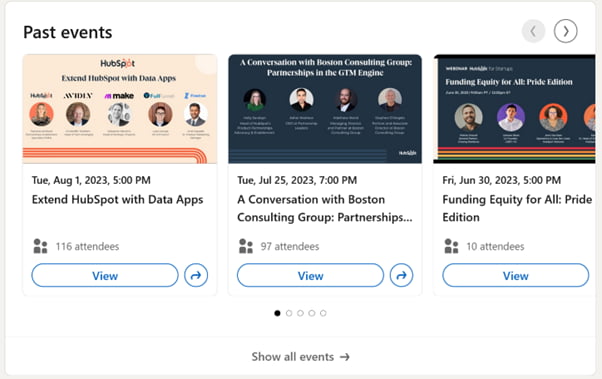
Source: linkedin.com/company/hubspot/
Here’s a screenshot of its account on Instagram, where HubSpot focuses on publishing quick information:

Source: instagram.com/hubspot/
That approach enables businesses to create more relatable content for the audience, resulting in engagement.
Contrary to popular belief, educational content doesn’t have to be text-heavy. You can use a mix of text, images, video, and other media formats to enhance your B2B content, helping you catch audience members’ attention as they scroll through their social media feeds.
Also, develop a content calendar outlining what kind of material you will post, how frequently, and on which social media channels. It will help you stay consistent and organized.
Finally, keep an eye on brand-related keywords, hashtags, and the latest trends and news in your industry. Align your social media content with those trends and stay relevant to provide value to your audience.
2. Share your company’s core values
Your brand’s values are the backbone of your operations. Sharing them on social media can be a game-changer in building trust with potential clients and boosting your business’s reputation
However, to communicate your values effectively, you must adopt a strategic approach.
Start by identifying your company’s core values and what makes you different. Ensure those values are communicated clearly on your website, social media bios, and marketing materials. Be true to yourself; don’t imitate another company’s values. (If you don’t know what your values are or how to express them via social media, you can engage PR services. A good PR firm can easily tell how you should package yourself as a brand for the best PR results.)
Cisco is an example of a company that shares its company’s core values regularly on social media. Its posts feature insightful quotes that emphasize innovation and technology.
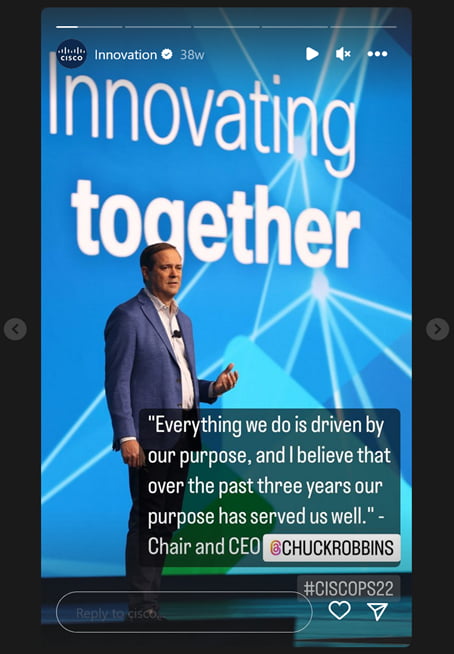
Source: instagram.com/stories/highlights/17966381546171569/
You can also share behind-the-scenes posts—for example, spotlighting employees who embody your values—and customer testimonials highlighting your company’s values.
3. Create posts that showcase your social cause
Aligning your brand with a relevant social cause can help build a positive image for you while raising awareness for critical issues. Corporate social responsibility is just as essential in B2B: Around 72% of B2B buyers are more likely to purchase from companies that espouse social issues they consider important.
So, if you haven’t done so already, select a cause that aligns with your brand’s values and resonates with your target audience. Then, create content highlighting the cause and how the company supports it. That content might be in the form of videos, livestreams, and written posts.
Check out the following excellent example from Hootsuite, which partnered with Witness Change, a nonprofit organization that helps improve the lives of excluded communities:
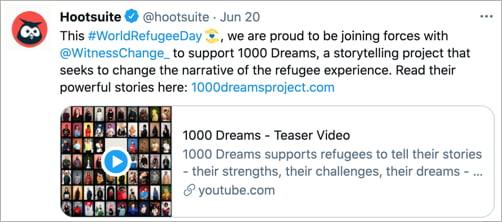
Source: Hootsuite
Finally, encourage your audience to get involved with your causes by donating or volunteering, for instance. Your company can also create a hashtag for the cause so that others can join in and share their support.
4. Promote collaborations with other brands
Collaborations with other brands can help your B2B brand expand its audience reach. Each partner brand gets to connect with the audience of the company or companies it partners with—is great for public relations. After all, the more people you reach with your PR messages, the better.
Plus, collaborations can help improve your brand reputation. When you associate yourself with a well-loved brand, that brand’s excellent reputation rubs off on you.
So, as part of your social media PR strategy, you should promote such collaborations, which can come in several forms. For instance, you can collaborate on online content, such as e-books and webinars.
Check out the following example; B2B company Kissmetrics partnered with Influence & Co. for its webinar on data-driven storytelling:

Source: Growfusely
Kissmetrics then promoted the webinar on its social media platforms, including Facebook, as part of its B2B SaaS marketing strategy.
The thing is, collaborations can’t always happen regularly. After all, brands need to invest a lot of their time and effort for them to materialize. So, as a B2B brand, what do you do in the meantime?
You can interact with other brands by commenting, liking, and sharing their posts. Again: associating your B2B brand with another good brand can help boost your reputation. Interacting and sharing others’ posts is one way you can form such associations.
That’s an approach Salesforce takes:
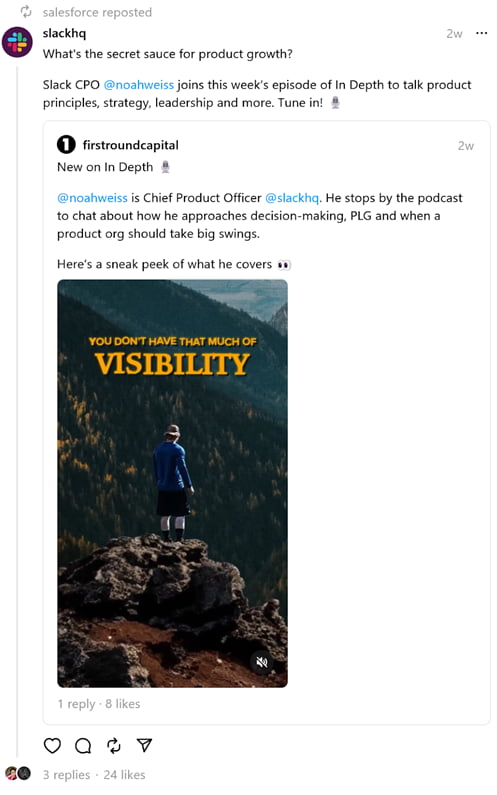
Source: threads.net/@salesforce
5. Announce incentives
Incentives encourage clients, leads, and prospects to take your desired action. They’re great for your PR, too. They show you’re a generous brand that doesn’t hesitate to reward good customer behavior.
Here are two ways to incorporate rewards into your social media PR efforts effectively.
Promote contests and giveaways. The reward should valuable in the eyes of your target audience. Consider this example from Hootsuite:
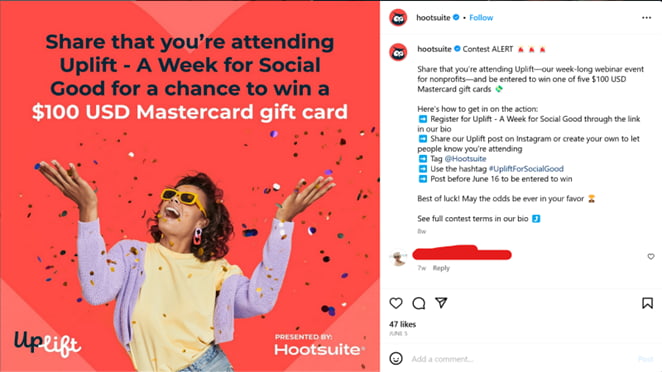
Source: instagram.com/p/CtHV1c0P1bN/
Align your reward with the products and services you offer so that you, as well, benefit when people take you up on your incentive.
Promote a loyalty program. The program might allow clients to earn points through referrals, for example, and accumulated points redeemed for rewards or exclusive content.
Also, encourage your customers to share their experiences on their social media profiles. When they do, you’ll have increased brand awareness and generate positive word-of-mouth.
* * *
Social media PR focuses on strategically managing your brand image. It can improve your brand presence, increase brand credibility, and drive sales and conversions.
To sum up the five social media PR tips in this article: publish high-quality educational content; share your company’s core values; create posts that showcase your social cause; promote your collaborations with other brands; and announce incentives.
Implement those social media strategies consistently, and you’ll reap the positive PR results.
